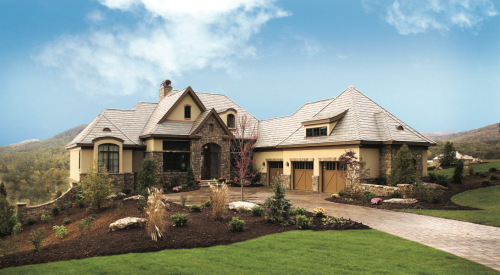Even during the dark days of the housing bubble burst, Jim LaVallee, principal of Epic Development, was “killing it on the margins.”
The home builder ratcheted up his remodeling business as Atlanta was awash with foreclosed houses available for as little as $30,000. From 2008 to 2010, LaVallee bought distressed properties on the cheap, fixed them up, and flipped them.
“We were making 30-to-40 percent on margin, but I could hardly get a bank to touch us,” he says. “I’ve got a track record and we’re well-capitalized, [but] I couldn’t get anybody interested.”
LaVallee jokes that the bankers who were willing to lend had less than generous terms: “Put all your money in their bank, and they’ll lend it back to you.” So the Chamblee, Ga.-based company sought out small banks that opened for business during the tail end of the housing bust. They didn’t have the legacy issues of the banks that got burned from lending construction and development loans during the boon days. The newbies also offered better terms.
“We target the small, de novo banks intentionally because they’re the types of banks that have limited markets where they can compete and lend,” LaVallee says. “That’s how we started. One of the negatives is the smaller banks can only lend so much and have so much money out with any one customer. So we also worked on having relationships with $1 billion and $2 billion [in assets] banks so we can grow.”

This Mediterranean-inspired home built by Epic Development in Atlanta’s Virginia Highlands community includes a two-story foyer, six bedrooms, and 5½ baths. Photo courtesy of Epic Development
Epic typically builds single-family homes on infill sites in established Atlanta neighborhoods and is about to close a deal to build 10 spec townhomes priced in the $600,000 to $700,000 range and another 16 units thereafter. LaVallee expects the townhome project will push Epic’s annual revenue up to $18 million next year from $13 million this year.
As with the economic recovery, whether credit availability for builders is improving depends on the ZIP code. At least on an aggregate level, Federal Deposit Insurance Corp. (FDIC) figures show the outstanding stock of one-to-four-unit residential acquisition, development, and construction (AD&C) loans made by FDIC-insured institutions increased 4.46 percent during the first quarter of 2014 compared with the previous quarter. While the stock of home building AD&C loans grew by 12.2 percent—or almost $5 billion—since first quarter 2013, lending activity still is well below peak levels set in 2007 and trails 10- and 20-year averages.
“I think the challenge for some of these banks is to what extent are they willing to get more proactive,” says Christopher Marinac, a banking analyst with FIG Partners, Atlanta. “Every company is different because there is a different attitude about how much leverage they will add. Leverage simply means how much construction relative to capital these companies are willing to take on. If you go back to pre-recession, you had banks that were lending at three-to-five times capital levels in construction lending. Today that number is nowhere near as big. It’s a much lower number—less than 100 percent of capital in many cases. We still have that issue where there are banks challenged to go anywhere near 100 percent of capital, let alone above it.”

Photo courtesy of Epic Development
More Cold-Calling
While leverage trails pre-recession levels, several builders noted they started fielding more phone calls and banker visits after mortgage refinancing activity began to slump. The banking industry’s only lucrative revenue spigot started to run dry when interest rates increased after Federal Reserve chairman Ben Bernanke mentioned in May 2013 there was a possibility the central bank would reduce debt purchases. Banks found themselves holding a pile of deposits that were not generating income.
“They are desperate to get loans on the books at this point, so real estate looked great; four years ago it was toxic,” says John Floyd, owner and CEO of Ole South Properties, Murfreesboro, Tenn. “Now it’s ‘What can we do to get your business?’ In this market, there isn’t a day that goes by where someone doesn’t call wanting to try to do some lending. We’re more likely to meet with a bank that is new to our business or new to us than to meet with banks that bruised us a little bit during the downturn. We’re kind of picky as to who we talk to.”
One prerequisite that bankers must fulfill to get Floyd’s business is funding land development. During the fall of 2011, Middle Tennessee banks started loosening credit but just for vertical construction financing. Only within the last six-to-seven months did they begin extending development loans, too.
“In our market there is a relative shortage of lots, so banks are desperate to do construction,” Floyd says. “At some point they really don’t have a choice. They got to get in the development business, or they lose that entire block of construction lending. I think that is what has driven the market here. I don’t think they want to get into the development lending business, but it’s kind of if you do one, you’ve got to do the other. That’s the way we look at it. If a bank is not willing to do development lending, then we’ll look elsewhere for our vertical construction loans.”

This Ole South home in the Puckett Station community of Murfreesboro, Tenn., offers almost 3,000 square feet, five bedrooms, and three baths. Photo courtesy of Ole South
Heather Dosch, CEO of John F. Buchan Homes, Bellevue, Wash., has worked steadily with two local bankers since the recession. Yet she feels as if she has been pursued by lenders ever since the mortgage and refinance market declined.
“I certainly didn’t feel that way back in 2010,” Dosch says. “Now I have quite a few people who would like to develop more relationships and lend more. We have been growing, so we are borrowing more than our overall long-term goals. I’ve got a third guy, [and] I told him I would give him a crack at the next project we have coming up. I’m sort of reluctant because I want to keep what we borrowed to as little as possible, and I have plenty of capacity in the loans we’re working with at the moment.”
As the Great Recession waned, California, Texas, and Washington, D.C., were among the earliest markets to show robust demand for new homes from move-up and move-down buyers. That’s where Wells Fargo picked up more lending business and quickly saw more banking competition for project and construction financing. The Charlotte, N.C.-based bank’s portfolio of borrowers primarily consists of three client types: National builders, public and private, who have access to public debt and equity markets and corporate syndicated credit facilities; middle-market builders who close between 125 and about 1,000 houses annually; and lot developers who either have a building company and/or a stable of builders for which they provide land.
“Our portfolio in the current environment has tended to be more regional segmentation because that is where we’ve seen the most opportunity,” says R. Bird Anderson Jr., executive vice president of home builder banking for Wells Fargo’s commercial real estate group. “We have focused on where the most opportunity is and where we get the most bang for our buck in terms of efficiencies.”
Overall, Anderson contends the level of AD&C financing is reflective of the level of demand in home sales. Indeed, builders report that bankers early in the recovery would underwrite loans at 65 percent loan-to-value, but now that ratio is higher in some cases. Also, lenders such as community banks initially would provide only construction loans, so the builders had to own the land free and clear. Today, some institutions are financing up to half of the land cost.
“It follows that chain. If there is demand for new homes, there is demand for project financing; and if there is demand for project financing, the banks along with other debt providers will respond,” Anderson says.

Photo courtesy of Epic Development
Non-Regulated Lending
Among those alternative lenders is Sabal Financial Group, Newport Beach, Calif., which opened its doors in January 2012. The non-regulated lender tends to stay short, financing projects with 100 lots or less with terms of three years or less. The financial services firm stays away from bigger, longer-term projects to reduce the risk of being mired with inventory when the next cyclical downturn hits.
The type of builder clients for Sabal’s loans runs the gamut, including publicly traded builders that seek non-recourse loans (debt obligation where the issuer seizes collateral property if the borrower defaults, but cannot seek further compensation from the borrower) for balance sheet management. Typically, such loans are not counted in the company’s leverage covenant, which enables the builder to take on more debt without affecting its ability to take on more leverage.
Presenting Your Best 'Execution Side' to a Nonregulated Lender
As with banks, non-regulated lenders like Sabal Financial Group, Newport Beach, Calif., examine financial records to assess whether to extend a loan to a potential builder client. But where commercial bankers direct more scrutiny to documentation on appraisal value for land, and/or vertical construction, inspections, and other administrative concerns, Tom Farrell, Sabal’s director of home builder finance, notes that it focuses more than banks do on variables dealing with the “execution side.” Because the financial firm is dealing with a non-recourse loan, “We want to make sure that at the end of the day we have a product to sell and get paid off because we don’t have the ability to go back and look for someone to perform on the guarantee,” he says.Character CountsHow did the builder handle his company with vendors, lenders, and trades during the downturn? “The home building community is small, so when you check with your industry resources, you can figure out who acted appropriately and who didn’t,” Farrell says.Do Your Homework“When we’re talking with a builder, and they’re very familiar with the comps in the market and with the new projects coming down the line that might compete with them, that gives us a comfort level that these guys really know what they’re doing,” Farrell says. “They have the ability to execute. If on the other hand, a builder’s answers about the market are vague, lenders are going have doubts about that candidate’s ability to execute.”Skill Set“We look at the builder’s team to make sure they have members of their team on the marketing side, the building side, and so on. If they don’t have a big team, we want to see that they have the necessary ingredients to get all facets of a home building project completed,” Farrell says. The financial firm has come across prospects who were regional managers for years with a big public builder before starting their own company. Rather than getting their hands into the “soup to nuts” aspects of the business, they delegated those responsibilities to someone else and consequently lack some skills and know-how. “Just because they were involved in building 2,000 homes for a public home builder doesn’t mean they can start and run their own business successfully,” Farrell says.The BlemishesThanks to the Great Recession, the industry is littered with builders who had bankruptcy, deed in lieu, and foreclosures on their record. Those events are not necessarily deal breakers. “The bottom line is were they upfront and proactive with their equity partners and lenders,” Farrell says. “Did they do everything they could do to honor their commitments? They might have been unable to handle all their obligations, but at least they tried to do something with the resources they had. That’s what we’re looking for. If we get in a tough spot with a builder, we know we are going arm in arm to try to resolve the problem and get the best possible outcome.”
Another client type is regional builders who otherwise might have to consider bringing in an institutional equity partner or private investors and give them a stake in a project. Sabal financing allows this builder to put in more of their own equity and, consequently, keep more of the profits from a project rather than split or give a bigger share to a partner.
Finally, small builders with financials too weak to be considered for a loan by traditional banks are lending candidates if Sabal is comfortable that the builder has enough liquidity and cash flow to handle any cost overruns with their project.
“Non-regulated money is expensive, but we see many home builders that are willing to pay more because they can get certainty of funding and get higher advance rates so they can bring in more equity to fund their projects,” says Tom Farrell, Sabal’s director of home builder finance. “Equity is your highest cost of capital, so that does allow them in a way to reduce their cost of funds by being able to use more leverage and less equity. It’s cheaper if you look at it from that perspective.”
Builders who were mistreated by banks are among Sabal prospects, as well as industry veterans trying to restart operations after losing almost everything. Those clients are reluctant to sign guarantees for recourse loans with banks because they don’t intend to be in the business very much longer and don’t want to put their personal wealth on the line again.
“Banks are looking for a strong balance sheet, whereas our loans are non-recourse. We look at the financials, but we spend more time analyzing the real estate than a typical bank does,” Farrell says.

Photo courtesy of Ole South
Hard Money
Regulators still focus on loan grading and credit quality, but there is also intense scrutiny on bankers’ appraisal and inspection policies, the application of those policies, flood insurance, and other administrative functions. While bank loan terms are much improved compared with three years ago, the loan application can seem burdensome and time-consuming compared with tapping capital from investors.
That’s one reason why the bulk of construction financing and some development funding for Renaissance Homes is sourced from private investors. The Lake Oswego, Ore., builder completed a planned reorganization by 2010 and today works with four banks, two of which the builder had ties with before the Chapter 11 filing. But during the early days of the company’s emergence from reorganization, it had no financing options. Through word of mouth, a real estate broker helped the builder recruit about a dozen wealthy individuals—they knew each other socially and some regularly played tennis together—to invest in Renaissance projects.
“A lot of what we’ve been doing is purchasing spot lots and putting things into production. It’s relatively time-constrained and I don’t think the banks can do anything in less than four or five weeks,” says Tim Breedlove, Renaissance’s chief operating officer. “These guys literally can do stuff in a matter of a couple of days. There’s no appraisal, none of that stuff. They just look at the property and if they like it, and they like the relationship with us, they go ahead. From a service standpoint, they’re great; but obviously we’re paying for it.”
Real estate can be as attractive an investment for private investors as it is for banks. Returns range anywhere from 8 percent to 12 percent. LaVallee added investors to his mix of capital sources and paid 8-to-10 percent with no points. He deemed those terms fairly affordable compared with bank loans once one adds the fees for appraisals, closing, and other bank costs.
Community banks have long been the bedrock of financing for builders but their decline—about 6,000 in number today compared with 7,139 in 2007 per the FDIC—suggests the pool of capital available from traditional lenders is shrinking. But those numbers may not foreshadow the future. While there is ongoing consolidation within the ranks of community banks, the majority of the institutions that disappeared had less than $100 million in assets. In two-thirds of the acquisition deals, the smaller banks were acquired by other community banks. A recent FDIC Quarterly report found the number of banks with assets between $100 million and $10 billion, which are still classified as community banks, actually increased both in numbers and in asset size since 1985. The report stated, “Our analysis shows that the projected decline of community banking sector has been significantly overstated.”
In Middle Tennessee there have been a handful of banks that were bought out recently, including one institution where Floyd sat on the board of directors. Yet he sees no need to pursue alternative financing or bring in investors. His company currently does business with 14 small banks, and there are at least another 25 to 30 more institutions he could approach for loans outside of that circle.
“Then you got your big banks who entice you with low rates and low cost,” he says. “We’re doing business with some big banks, but we’re sticking with small community banks for our source of funding. They’re the ones that helped us make it through the downturn.”
PB Topical Ref













